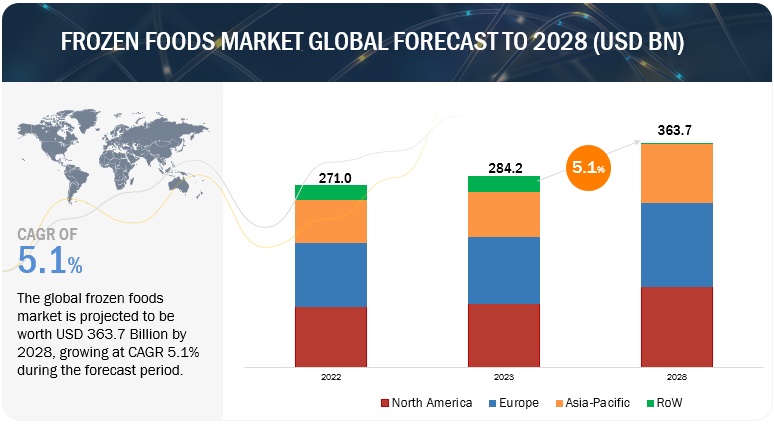
The global frozen foods market is projected to reach USD 363.7 billion by 2028 from USD 284.2 billion by 2023, at a CAGR of 5.1% during the forecast period in terms of value. One of the primary advantages is their longer shelf life compared to fresh alternatives. This quality significantly reduces food waste, a growing concern globally. Consumers can confidently stock up on frozen foods, knowing they won’t spoil quickly, aligning with sustainability goals.

Download PDF Brochure: https://www.marketsandmarkets.com/pdfdownloadNew.asp?id=130
Drivers: Rapid Growth in the Packaged Food & Beverage Drives Growth in the Frozen Foods Market
The rapid growth in the packaged food and beverage industry is significantly fueling the expansion of the frozen foods market. This synergy can be attributed to several key factors. Firstly, the packaged food and beverage sector is experiencing increasing demand due to changing consumer lifestyles and preferences. Convenience, portability, and longer shelf life are all characteristics that appeal to today’s busy consumers.
Frozen foods align seamlessly with these trends, providing convenient, ready-to-eat or easy-to-prepare meal options. They offer a practical solution for individuals and families seeking quick, hassle-free dining choices in the packaged food realm. Furthermore, the packaged food industry’s robust distribution networks and marketing strategies make it easier for frozen food products to reach a broader consumer base. This collaborative growth strengthens both sectors, as they cater to evolving consumer needs for convenience and variety in their food choices.
Based on type, the raw material segment is estimated to hold the largest market share during the forecast period of the frozen foods market.
Raw frozen food is poised to dominate the frozen food market due to its versatility and appeal to a wide range of consumers. This category encompasses an array of products, including fruits, vegetables, seafood, and meats, offering consumers the flexibility to create diverse and customized meals. Raw frozen foods retain their inherent nutritional value and flavor, often outperforming their cooked or processed counterparts. Furthermore, they cater to various dietary preferences, such as vegan, paleo, and gluten-free diets, making them inclusive and adaptable. In an era where health consciousness and convenience intersect, raw frozen foods align perfectly, allowing consumers to prepare fresh, wholesome meals with minimal effort. This appeal is driving their popularity, ensuring that raw frozen food remains the largest share of the frozen food market.
Based on consumption, the retail segment is anticipated to witness the highest growth in the frozen foods market.
The COVID-19 pandemic has accelerated the trend of consumers stocking up on frozen essentials due to their longer shelf life, providing a boost to the retail frozen food segment. Additionally, as consumers become more health-conscious, frozen foods are evolving to offer a wider range of healthier options, including organic and low-calorie choices, further appealing to a health-focused demographic.
Furthermore, retail channels provide a convenient and accessible distribution network, making it easier for consumers to purchase frozen foods. With the ongoing expansion of e-commerce and online grocery shopping, retail frozen foods are well-positioned to capture a significant share of the market as they cater to the evolving preferences and needs of today’s consumers.
Request Sample Pages: https://www.marketsandmarkets.com/requestsampleNew.asp?id=130
Germany is expected to account for the largest market share in 2023.
Germany is poised to dominate the frozen foods market for several compelling reasons. The nation’s strong economy and high levels of consumer purchasing power make it an attractive hub for frozen foods. Additionally, Germany’s shifting demographics, characterized by a growing number of working professionals and single-person households, fuel the demand for convenient meal solutions. Frozen foods are well-aligned with these changing consumer preferences, offering quick and effortless preparation options. Furthermore, Germany places a significant emphasis on food safety and quality, and frozen foods are perceived as a secure and dependable choice. This trust in the quality and safety of frozen products further solidifies their dominance in the market.
Major players operating in the frozen foods market are General Mills Inc. (US), Nestlé (Switzerland), Unilever (Netherlands), McCain Foods Limited (Canada), Conagra Brands, Inc (US), Kellogg’s Company (US), Grupo Bimbo (Mexico), and The Kraft Heinz Company (US).
